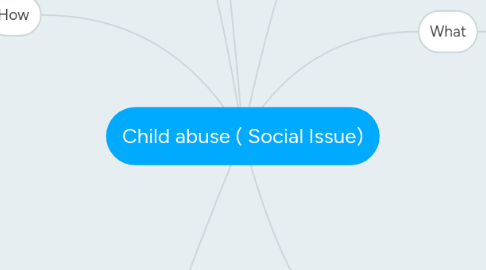
1. Who
1.1. child
1.2. abuser
2. How
2.1. to help stop it
2.1.1. volunteer your time
2.1.1.1. get involved with other parents in your community
2.1.2. disicipline children thoughtfully
2.1.2.1. never discipline your child when you are upset
2.1.3. educate yourself and others
2.1.3.1. after-school activities, parent education classes, mentoring programs, and respite care are some of the many ways to keep children safe from harm
2.1.4. teach children their rights
2.1.4.1. when children are taught they are special and have the right to be safe, they are less likely to think abuse is their fault, and more likely to report an offender.
2.1.5. support prevention programs
2.1.5.1. greater investments are needed in programs that have been proven to stop the abuse before it occurs
2.1.6. know the signs
2.1.6.1. fear of a certain adult, difficulty trusting others or making friends, sudden changes in eating or sleeping patterns, inappropriate sexual behavior, poor hygiene, secrecy, and hostility are often signs of family problems and may indicate a child is being neglected or physically, sexually, or emotionally abused
2.1.7. report abuse
2.1.7.1. if you witness a child being harmed or see evidence of abuse, or if a child tells you about abuse, make a report to your state's child protective services department or local police.
3. Why
3.1. isolation and lack of support
3.1.1. when there is no one, such as extended family, friends, a partner or community support to help with the demands of parenting
3.2. stress
3.2.1. financial pressures, job worries, medical problems or taking care of a family member with a disability can increase stress and overwhelm parents
3.3. unrealistic expectations
3.3.1. a lack of understanding of a child or young person's developmental stages and behaviour
3.4. lack of parenting skills
3.4.1. not knowing how to help children and young people learn, grow and behave in a positive way
3.5. drug and alcohol problems
3.5.1. addiction or substance abuse may limit a parent's ability to meet their children's needs
3.6. low self esteem and self confidence
3.6.1. sometimes insecure parents doubt their ability to meet their child's needs and do not seek help and support poor childhood experiences
4. sources
4.1. http://www.redcross.ca/how-we-help/violence--bullying-and-abuse-prevention/educators/child-abuse-and-neglect-prevention/definitions-of-child-abuse-and-neglect https://www.childhelp.org/child-abuse/ https://www.communities.qld.gov.au/childsafety/protecting-children/what-is-child-abuse/why-does-child-abuse-happen
5. What
5.1. an attempt to control the behaviour of another being, any form of physical, emotional and/or sexual mistreatment or lack of care that causes injury or emotional damage to a child or youth.
5.1.1. Physical Abuse: Physical abuse of a child is when a parent or caregiver causes any non-accidental physical injury to a child.
5.1.2. Sexual Abuse: Sexual abuse occurs when an adult uses a child for sexual purposes or involves a child in sexual acts
5.1.3. Child Neglect: Child neglect is when a parent or caregiver does not give the care, supervision, affection and support needed for a child’s health, safety and well-being.
5.1.3.1. Physical neglect and inadequate supervision
5.1.3.2. Emotional neglect
5.1.3.3. Medical neglect
5.1.3.4. Educational neglect
5.1.4. Emotional Abuse: When a parent or caregiver harms a child’s mental and social development, or causes severe emotional harm
6. When
6.1. under 18 yeaers
7. Where
7.1. ANYWHERE
7.1.1. school
7.1.2. in poor, middle class, well-to-do homes
7.1.3. in any ethnic, cultural, occupational, religious and age groups
7.1.4. in child's own home or outside it
7.1.5. involving one or both parents
7.1.6. in rural areas, suburbs, cities

